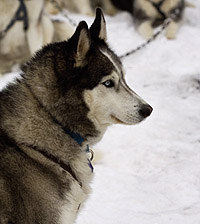Training
For You
You don't have to be incredibly fit to go dog sledding but a reasonable level of fitness is nesscessary. Contrary to what many people thing, when dog sledding you don't spend all of your time on the sled having the dogs pull you. When it comes to a hill or an area of ground which is slightly more dangerous you may have to help the dogs by pushing the sled while they pull or running alongside them. It's an extremely physical task so make sure you're in reasonable shape - especially if you're planning a trip that will last over several days.
For The Dogs
If you've got your own dogs and are training them, here's some helpful advice:
One of the most important things to do is start young. Get a puppy used to its harness, just as you would a collar and leash. Also let the puppy get used to pulling things. Start out something small 2x4 and let the puppy drag the it around behind its harness for a while. The emphasis is NOT on weight, just on having fun dragging a VERY LIGHT weight behind it. It is important to realize that one can injure a puppy's bones, structure, and spirit by doing too much!
To train adult dogs, or continue the puppy training as an adult, is relatively simple. Some dogs are natural pullers, others are not. Some dogs take right to the harness the first time, and other dogs, even ones from reputable breeders, may take extensive training. You just never know.

It is vital to get the dog to lean out and keep the line between it and you taut. Some dogs have a real problem with this, others do not. For problem dogs, the cause usually is due to the dog not liking you to be behind it. If you do have trouble, there are a variety of methods you can use. As long as you make training a fun game, and you make the dog understand what you want it to do, training will progress quickly, even for stubborn dogs, like Siberians. Fortunately, they LIKE to pull, so their stubbornness is not a problem here. Sometimes getting them to STOP pulling is!
Some mushers feel that it is best to train dogs to pull lots of weight, then speed comes naturally in a race without the weight. Others feel that speed and endurance training is best. Still others feel that a combination works best, similar to the combination training for the musher. Training for speed and endurance by mushing shorter distances (under 10 miles, sometimes even 3 or 4 miles) at top speed and up hills is beneficial. Loping along at 3 or 4 miles an hour for 15 or 20 miles is also beneficial. Both of these build strength and endurance. Pulling heavy weight for short distances is also quite good, particularly for wheel dogs (the ones hitched closest to the sled). For this, try a plastic tub to which you can add plastic weights (the ones from barbell sets will have the weights printed on them).
Whichever method you use, remember to take it easy with your dogs and not push them to hard, and never, NEVER, lose your temper with your dogs. Remember that this is supposed to be fun for both you and the dogs.
Lead Dogs
To successfully mush, one must have a good lead dog (or dogs). This dog will take your commands for regulating speed and direction for the entire team. Naturally, if you are driving only one dog, that will be your lead dog.
The basics are you want the dog to learn to turn right, left, speed up, and slow down on voice command. You also want the dog to bypass interesting detours and distractions. In addition to the basic commands already introduced, the dog must also be taught to speed up and go by distractions.


